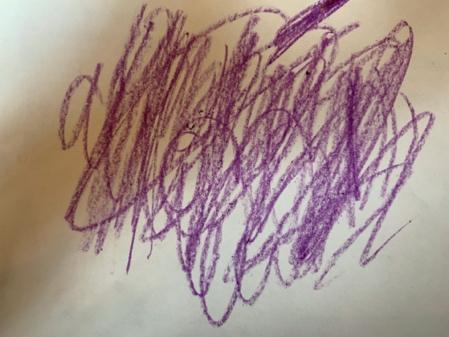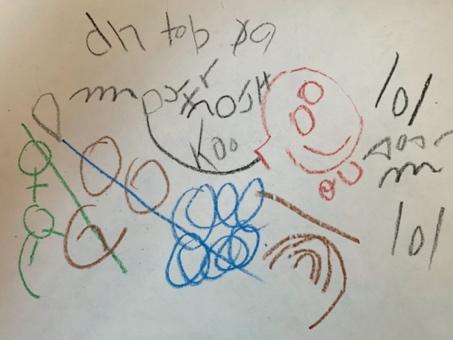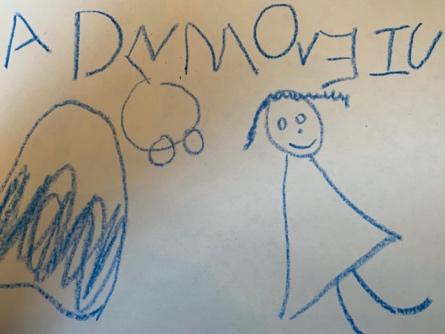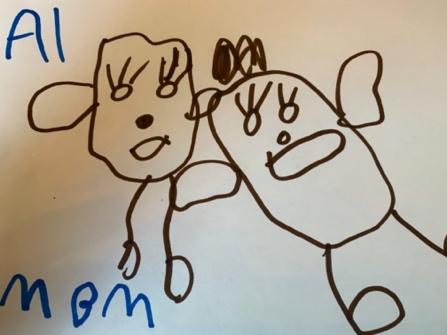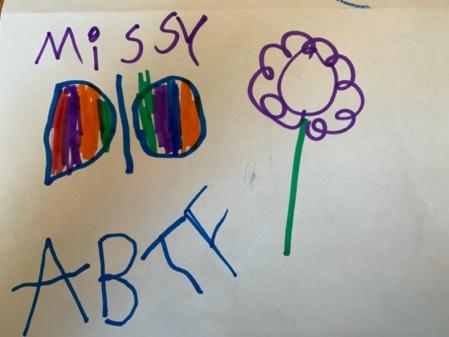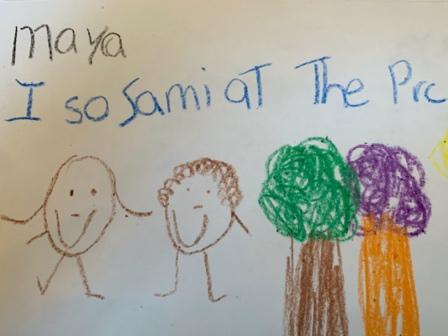9. Writing Development: Nurturing Emergent Writers
With Christopher K. Kidd
“The writer is an explorer. Every step is an advance into a new land.”
-Ralph Waldo Emerson
9.3 How Emergent Writers Progress
9.4 Nurturing Emergent Writers
Opening Vignette: Young Writers
Mr. Jenbere and Ms. Daryl combine classes for most of the school day. Mr. Jenbere’s class is a federally funded prekindergarten classroom with 18 students. Two of Mr. Jenbere’s students have Individual Education Programs (IEPs) and one of them uses a wheelchair. Ms. Daryl’s preschool class is for children who are identified as deaf and hard of hearing. All six of her students have IEPs. The students in these classes range in age from 2- to 5-years-old. Mr. Jenbere and Ms. Daryl believe that their co-teaching and inclusive practices strengthen the school experience of the children in both classes. Each of these classes has a paraprofessional and support from a variety of specialists, which gives these children a team of dedicated educators working towards their healthy development.
Mr. Jenbere and Ms. Daryl provide meaningful opportunities for writing throughout the day, including a specific time designated for writing instruction. They make an effort to connect writing instruction with all aspects of the curriculum in authentic ways. Today, the children are writing thank you notes to the assistant principal, who read them a story this morning. The children are gathered around tables with educators who are considering each child’s strengths and needs as they support and guide children during their writing time. They know that the unique abilities of individual learners must be considered in addition to the goals that they have for all of their children.
At Mr. Jenbere’s table, six children are engaged in writing using a variety of materials, including white unlined paper, colored construction paper, cardstock, markers, and crayons. Three children are using markers to draw pictures of the story the assistant principal read. They are talking to each other about the story as they draw. Arzu is using a crayon to scribble and is talking to herself as she writes. Mr. Jenbere helps Hasan identify the sounds in a word and then turns his attention to Richelle who reads her thank you note aloud. After listening to Richelle, he jots down an anecdotal note that documents not only the writing skills she used but also insights related to her comprehension of the story. Later, Mr. Jenbere and Ms. Daryl compare their anecdotal notes as they make plans for tomorrow’s writing instruction. They understand that assessment during writing instruction provides a window into the children’s learning and development.
9.1 Introduction
Like emergent reading, emergent writing provides a critical foundation for future literacy development (NELP, 2008). When young children, like the children in Mr. Jenbere’s and Ms. Daryl’s classes, are provided opportunities to draw, scribble, and write, they gain understandings of the role print plays in their lives and the way writing is used to communicate ideas (Kidd et al., 2014). Through these experiences, young children learn they can write to express their thoughts, share stories, communicate information, and convey opinions. Like Richelle, they begin to view writing, including their drawings and scribblings, as symbolic representations that enable them to communicate with their classmates, family members, teachers, and others. They also develop an understanding that writing can be used to make notes for themselves, such as play plans and reminders. As they write, they gain insights into writing as a process and develop a sense of ownership of their writing. In addition, like Hasan, they start to develop understandings of written conventions, including sentence structure, spelling, grammar, and mechanics. At the same time, children’s fine motor and handwriting skills also begin to develop.
Literacy processes are reciprocal and symbiotic in nature. When young children are engaged in activities that foster their emergent literacy skills, they begin to see the interrelationship among language, reading, and writing and are able to draw upon their emerging knowledge to enhance their literacy development (Goodman & Goodman, 1983). Conceptually, children at a young age begin to understand that reading and writing are communication processes. When children write, these processes are integrated as they read and reread their written message (Sulzby & Teale, 1985). This is seen with a child, like Richelle, as she listens to a story, writes a thank you note, and reads the thank you note to her teacher. At the same time, children are developing emergent literacy skills, such as phonological awareness, alphabetic principle, and concepts of print. These emergent reading skills influence skill development in writing and vice versa. For example, a child like Hasan, who is writing letters and words by listening to the sounds in a word and writing down the corresponding letter, is using his emerging understanding of letter-sound correspondence. As he strengthens his skills in letter-sound correspondence in writing, he enhances his ability to apply these skills when reading. Similarly, as he reads and develops his abilities to decode (read) words, he will develop his abilities to encode (write) words. By engaging in activities that develop these skills, he will become more proficient at generating text as he writes and generating meaning from text as he reads.
Discussions that situate emergent writing within the broader context of literacy development and acknowledge the interrelationship between reading and writing are important to understanding children’s literacy development. However, too often, writing is not given the time and attention that is needed in early childhood education classrooms (Pelatti et al., 2014). Therefore, in this chapter, we will focus specifically on understanding children’s writing development and how to use this knowledge to assess, plan, and implement meaningful writing experiences throughout the school day and at home. We will also examine factors that influence children’s emergent writing development. Developing these understandings is critical to ensuring that writing instruction is an integral part of the instructional day and multiple opportunities for writing are provided across the school day as well as at home.
Figure 9.1 Framework for Developing Emergent Literacy
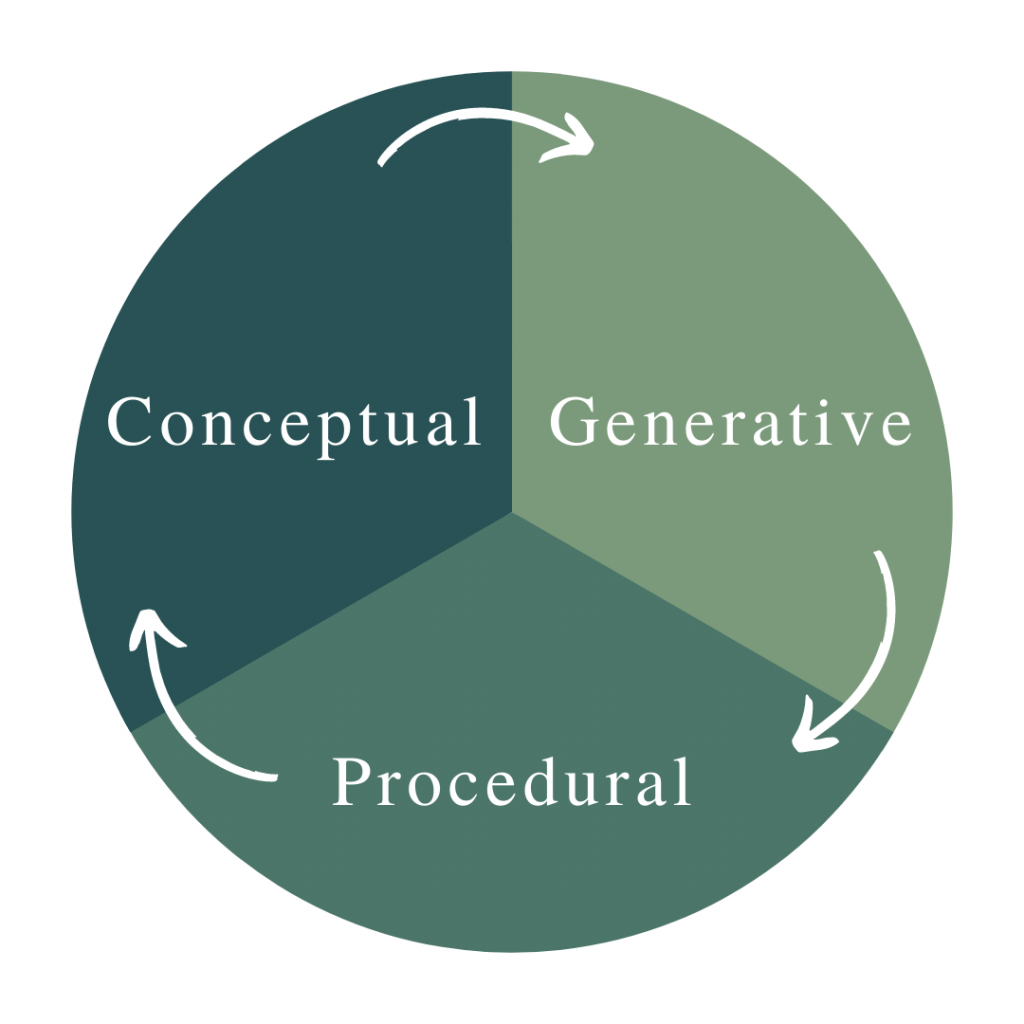
In this chapter, we will use the Framework for Developing Emergent Literacy (see Figure 9.1) introduced in the previous chapter to explain the dimensions of emergent writing (Puranik & Lonigan, 2014). The first dimension, conceptual knowledge, focuses on the conventions and functions of writing, including children’s understandings of how print works and that print conveys meaning. The second dimension, procedural knowledge, focuses on the mechanics of writing, such as knowledge of the alphabet, name writing, letter writing, spelling, and handwriting. Lastly, the third dimension, generative knowledge, focuses on composing phrases and sentences that communicate meaning. For very young children, generative knowledge includes the emerging ability to communicate intentionally with others using drawings, scribblings, and symbolic representations. Using the Framework for Developing Emergent Literacy, this chapter will answer the following questions:
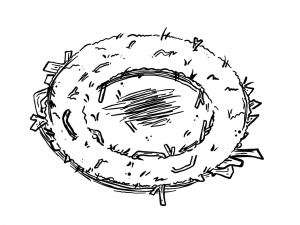 How do young children develop an understanding that writing conveys meaning and they can write to communicate their thoughts and ideas?
How do young children develop an understanding that writing conveys meaning and they can write to communicate their thoughts and ideas?
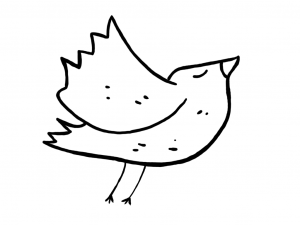 How do emergent writers progress on a continuum of development?
How do emergent writers progress on a continuum of development?
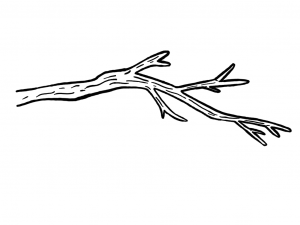 What can early childhood educators do to support emergent writers using effective instructional strategies and literacy assessments?
What can early childhood educators do to support emergent writers using effective instructional strategies and literacy assessments?
 9.2 Writing is Communicating
9.2 Writing is Communicating
Children learn at a young age that people use writing to express their thoughts, share stories, communicate information, and convey opinions. Within their homes and in the community, young children have opportunities to observe the functions of writing in their day-to-day lives. For example, children might see family members write a grocery list and then observe their dad read the list and cross off items while walking down the aisles of the grocery store. Or perhaps, they notice their mom write a note for an older sibling and then watch as the sibling later reads the note and takes fruit out of the refrigerator for a snack. Likewise, they may witness their sibling’s efforts to lobby for a new game by posting notes at strategic places around the home. As they sit on the couch next to an uncle, they could have an opportunity to watch him take out his phone, type in a text, and send the message to a friend. Out in the community, they might notice the server writing down their family’s order and then bringing the items requested to their table. Likewise, they could observe an auto mechanic writing down their family’s phone number and promising to give a call when the car is ready. These types of interactions in the home and community develop children’s conceptual knowledge of writing and their understanding of writing as a way to communicate.
Learning about writing continues to take place as children engage in writing activities not only in the home, but also in the classroom. For example, the children in Mr. Jenbere’s and Ms. Daryl’s classroom in the vignette above are developing their writing abilities and practicing their writing skills as they write their thank you notes. This activity provides an opportunity for children to draw pictures and talk about the story the assistant principal read as they write their thank you notes. Through their pictures, they record thoughts that are important to them with the understanding that these ideas can then be shared with others. At the same time, an activity like this allows children, like Arzu, to capture their thoughts through scribbles. Likewise, children, like Hasan, use their growing knowledge of letters and sounds to add words to their notes. This type of activity also enables children, like Richelle, to develop their understanding of the permanency of writing and to see themselves as writers with an audience. The children’s emerging understandings of writing are apparent in these efforts.
The Framework for Developing Emergent Literacy presented above provides educators with a way to think about children’s writing development. This framework recognizes the interrelationship between reading and writing and organizes emergent writing into three dimensions: conceptual, procedural, and generative knowledge (Puranik & Lonigan, 2014). These dimensions are important to consider when assessing children’s writing and planning and implementing instruction.
As writing is utilized in children’s everyday lives, their conceptual knowledge of writing develops and they gain insights into how print works. Puranik and Lonigan (2014) define conceptual knowledge as skills that “represent knowledge about the conventions and functions of writing” (p. 465). At a young age, children learn that writing is a means for communicating thoughts. They gain insights into the purposes or functions of writing and recognize that they can write to express ideas and feelings, tell a story, share information, and present an opinion or point of view. They also develop concepts of print specific to writing, such as writing in English occurs from left to right. In addition, they begin to understand writing as a symbolic representation of ideas as they recognize and assign meaning to logos, markings, and symbols they encounter (Byington & Kim, 2017).
At the same time, young children develop procedural knowledge of print. Puranik and Lonigan (2014) define procedural knowledge as “knowledge of the specific symbols and conventions involved in the production of writing” (p. 456). These skills are important to children’s future ability to use predictable letter-sound relationships to read and write fluently. As children develop procedural knowledge, they gain understandings of the alphabetic principle. As noted in Chapter 8, the alphabetic principle involves learning letter names and the sounds associated with them. Young children apply these principles as they begin to write letters and words, including names. As children gain an understanding of letter-sound relationships, they use this knowledge to help them spell words. Developing children’s fine motor skills and handwriting is also important in the early years (Byington & Kim, 2017).
Children’s generative knowledge of writing develops as they apply their conceptual and procedural knowledge of writing. Puranik and Lonigan (2014) define generative knowledge as “children’s emerging ability to compose phrases and sentences in their writing” (p. 456). Initially, young children use inventive markings to express ideas and convey important messages. Often, when we ask children to “tell us what you wrote,” they will hold up their drawing and point to the markings and orally state the phrases and sometimes sentences they composed. Even though these children may not be able to form letters yet, they are still applying their understanding about how writing communicates a message that can be shared. Over time, children begin to use letters as symbolic representations that are organized to signify meaning (Bialystok, 1992). Experiences during the early years provide a foundation for children’s later ability to use particular strings of letters to represent specific words and to use these words to compose phrases and sentences that communicate meaning (Puranik & Lonigan, 2014). In the early years, a foundation for generating meaningful text is laid as children use oral language and writing, including drawing and scribbling, to communicate (Byington & Kim, 2017).
Understanding how conceptual, procedural, and generative knowledge of writing develops in young children helps educators assess children’s writing and plan for differentiated instructional experiences that develop children’s emerging writing abilities. In the next section, we describe how emergent writers progress. Educators use this knowledge of writing progressions to inform the decisions they make when planning and implementing assessment and instruction.
 9.3 How Emergent Writers Progress
9.3 How Emergent Writers Progress
As children interact with the world around them, their writing abilities develop along a continuum from emergent to more conventional writing. This pathway is not exactly the same for each child because children develop differently due to a variety of factors that will be discussed below. This was apparent in Mr. Jenbere’s and Ms. Daryl’s classroom with Arzu who was scribbling and Hasan who was using his knowledge of letters and sounds to write. Both were 4-year-olds writing a thank you note. However, procedurally, they were at different places along the continuum in terms of the writing they produced.
Although children’s developmental pathways vary by individual child, understanding children’s writing progressions can help educators as they assess children’s writing abilities, plan instruction, and provide a variety of learning experiences. In this section, we use the framework from Virginia’s Early Learning and Development Standards (ELDS): Birth-Five Learning Guidelines to frame our discussion (see Table 9.1). In this framework, emergent writing skills are organized into three categories: writing to communicate, developing writing habits and skills, and handling writing tools. In each of these categories, the development of specific skills is broadly organized by age ranges. These age ranges are intended to provide a general understanding of typical progressions and are not to suggest that there is a simple linear progression of writing abilities. In actuality, children’s writing progresses as they increase their use of more advanced writing strategies and decrease their use of less advanced writing skills (Rowe & Wilson, 2015). For example, as children begin to use conventional letters, they may continue to scribble and use letter-like forms. Over time, they will decrease their use of scribbles and letter-like forms and will increase their use of conventional letters. For this reason, it is important to keep in mind that, although writing is a sequenced progression, there will be variability among children, as well as within children, as they are progressing along the continuum (Rowe & Wilson, 2015).
9.3a Writing to Communicate
As was evident in Mr. Jenbere’s and Ms. Daryl’s classroom, young children begin to understand that writing is a means to communicate thoughts, stories, information, and opinions. At an early age, children realize they can create drawings and make scribbles that they can then read to others (Bruyere, 2020). They come to understand that writing is intentional and is used to convey meaning (Rowe & Wilson, 2015). As their writing becomes more intentional, they begin to write for a variety of purposes and audiences and become more aware of the need to write so others can read their writing (Bruyere, 2020; Rowe & Wilson, 2015). They also become more cognizant of how the content of their writing varies depending on social expectations (Rowe & Wilson, 2015). For example, they learn what to include when they write a birthday card for a classmate or a story about a walk their family took in the park. Young children also develop a sense of ownership over their writing and begin to develop their identity as a writer (Bruyere, 2020; Kissel & Miller, 2015; Rowe, 2018).
Table 9.1 “Continuum of Emergent Writing Development: Writing to Communicate”
Continuum of Emergent Writing Development: Writing to Communicate
|
Developmental Progression |
CLLD3.1 Drawing, scribbling, and writing to communicate |
|
Early Infancy 0-8 months |
|
|
Later Infancy 6-14 months |
|
|
Early Toddler 12-24 Months |
|
|
Later Toddler 22-36 Months |
|
|
Early Preschool 34-48 Months |
|
|
Later Preschool 44-60 Months |
|
Table 9.1 is from Virginia’s Early Learning & Development Standards (ELDS): Birth-Five Learning Guidelines. It is used with permission of the creators and is not an open education resource covered by a Creative Commons License.
9.3a1 Initial markings. Young children’s journey as writers begins at an early age when they move from making accidental markings with little to no motor control to moving their forearm to make large intentional scribbles (Rowe & Wilson, 2015). As children’s fine motor skills develop, they use their hand and wrist movements to make more refined scribbles (see Figure 9.2). These scribbles initially represent objects and then begin to represent ideas, words, and phrases. As children’s writing progresses, they scribble in a more linear manner using spaces between their scribbles, up-and-down looping motions, circles, waves, swoops, and zig zags. Over time, they add letters, which may be written backwards or upside down, to their scribbles and letter-like forms. Scribbles are eventually replaced with conventional capital and lower-case letters; however, there is no correspondence between letters and sounds (Rowe & Wilson, 2015).
Pause and Consider: Scribbles, Letter-Like Symbols, and Letter Formations
In Figure 9.2, there are three preschool writing samples. Use the writing continuum above to analyze the children’s writing. Consider the following questions:
● What do you notice about these writing samples?
● What aspects of the descriptions about scribbling and letters do you see in these samples?
● What do you notice about the drawings?
● What does their writing show about what they know?
Figure 9.2 Scribbles, Letter-Like Symbols, and Letter Formations
|
|
|
|
|
Butterfly |
The big red monster said, “I will chase you.” I said, “You can’t get me because I run fast.” |
My mom is at the store. |
9.3a2 Moving toward using letters. Children also start to write their name and other words or phrases they have memorized (Rowe & Wilson, 2015). They learn to write their full name in English, for example, using capital and lowercase letters written from left to right. They also recognize their name as separate from their writing and that their name indicates ownership of what they produced. In addition, they begin to use conventional letters to write words and phrases they have memorized, like family members’ names, and phrases, such as, “I like cake.” They also begin to copy numbers, letters, and words from the environment into their writing.
Eventually, children start to write letters and groups of specific letters to represent their ideas as they use their growing knowledge of letters and sounds to write words, phrases, and sentences (Rowe & Wilson, 2015). This practice is often referred to as invented spelling. Initially, children tend to represent words using the initial letter sound (see Figure 9.3). For example, they might use “k” to represent “car” or “b” to represent “ball.” As children progress, they may write the initial and the final sounds (e.g., bk for bike) and eventually add middle consonant sounds (e.g, ktn for kitten). They add vowels (e.g., babe for baby) and begin to use correct spelling of some words (e.g., sat) as they move toward more conventional spelling.
Children are also developing understandings about directionality as their writing progresses (Rowe & Wilson, 2015). During the early years, children are learning how print is positioned on a page and the direction that print is written and read. For example, in English, children learn to write from left to right, move to the next line, and begin on the left again. Initially, children may place marks and scribbles anywhere on the paper. As they start to develop an understanding that writing is presented in a linear format, they may write from right to left horizontally or from top to bottom vertically. As children gain writing experience, they will begin to show more conventional directional patterns as they write.
Pause and Consider: Letter-Sound Correspondence
In Figure 9.3, there are three prekindergarten writing samples. Use the writing continuum above to analyze the children’s writing. Consider the following questions:
● What do you notice about these writing samples?
● What aspects of the descriptions about letters and words do you see in these samples?
● What do you notice about the drawings?
● What does their writing show about what they know?
Figure 9.3 Letter-Sound Correspondence
|
|
|
|
|
My brother and me |
A butterfly |
I saw Sammy at the park. |
9.3b Developing Writing Habits and Skills
As children develop their ability to communicate through writing, they also develop writing habits and skills (see Table 9.2). These writing habits and skills initially include showing interest in writing and experimenting with writing tools, such as crayons, markers, and touchscreen tablets. In addition, children begin to share drawings and writings with others as they become more aware of their audience and begin to see writing as a socially negotiated act between the writer and the audience (Kissel, 2018). They also develop their identity and voice as writers and gain greater insights into the power of writing (Kissel & Miller, 2015). Initially, they may orally label or explain the objects they draw. Over time, they begin to use their writing to represent and communicate ideas, stories, information, and opinions.
Table 9.2 “Continuum of Emergent Writing Development: Developing Writing Habits and Skills”
Continuum of Emergent Writing Development: Developing Writing Habits and Skills
|
Developmental Progression |
CLLD3.2 Developing Writing Habits and Skill |
|
Early Infancy 0-8 months |
|
|
Later Infancy 6-14 months |
|
|
Early Toddler 12-24 Months |
|
|
Later Toddler 22-36 Months |
|
|
Early Preschool 34-48 Months |
|
|
Later Preschool 44-60 Months |
|
Table 9.2 is from Virginia’s Early Learning & Development Standards (ELDS): Birth-Five Learning Guidelines. It is used with permission of the creators and is not an open education resource covered by a Creative Commons License.
As children represent their ideas in writing, they develop an understanding of writing as a process (Kissel et al., 2011). They become aware that they can plan, draft, revise, edit, and share their writing (Kidd et al., 2014). They learn that planning involves selecting a topic and generating ideas. As children talk, listen, and observe, they gather topics and ideas for writing. Children also plan what they want to write through their drawings. As children draw and add details to their drawings, they generate ideas that they can convey orally as well as through scribbles, letter-like forms, letters, words, phrases, and sentences.
Young children gather ideas for their drawings and writing from their own lives. They draw and write about their everyday and special activities, family and friends, stories that have been read to them and/or that they have seen on media, and content they are learning at home and in school (e.g., plants, weather, recycling, etc.). They are also influenced by the thoughts and interests of their peers. As they see their friends draw and write about trucks, they, too, might become interested in drawing and writing about trucks. In addition, adults may have an effect on what children draw and write. For example, children whose family members write letters or emails to friends might decide to write their own letter or email. Likewise, children whose teachers model writing about the plants growing in the classroom might develop an interest in writing about the plants.
As they write and share, interactions with their peers may prompt children to revise their plans. For example, one day, Richelle decided she was going to write about swimming and had started to draw a picture of a swimming pool. As she drew, she noticed Arzu was busy writing invitations to a party. This new idea intrigued her. After a brief conversation with Arzu, Richelle decided to revise her writing plans to include writing an invitation for Arzu to go swimming with her.
Young children also revise and edit as they write (Kidd et al., 2014). Revisions can occur while writing or can be details that are added, deleted, or changed at a later time. For example, a child might add more details to a story as he looks at his picture and realizes there is more to say or might decide to take his sister out of the story because he remembered he was mad at her. A child could also change her mind and decide that the ball is blue rather than red or that there are two balls rather than one. Children’s revisions are often influenced by their peers and adults as they interact with the writing. For example, once Richelle decided to write an invitation, she added Arzu to the picture of the pool. Using letter-like forms and some letters, she wrote, “Will you go with me?” After looking at her picture, she added additional writing to include “to the pool.” As she read her invitation aloud, Hasan interjected that he wanted to go, too. He then said that she needed to say which day or they would not know when to go. Richelle added “on Saturday” to her writing and added a picture of Hasan in the pool with them. After she shared the invitation, Ms. Daryl mentioned that an invitation usually includes what time she wants her friends to meet her. Richelle added a time to her invitation. Through these interactions, Richelle gained important insights into revising her writing.
Young children also learn about editing as they write and interact with others. Edits occur as children make corrections to their writing. This might happen when a child notices that he drew two cars and then adds an s to the label “car” to convey that there is more than one car. Editing also occurs when a child, like Arzu, remembers that her name begins with a capital letter and changes the lowercase a to a capital A. Interactions with peers and adults can also prompt children to edit their writing. For example, a child who is applying his knowledge of letter-sound relationships to sound out words might notice one of the words in his writing is posted on the wall. When he realizes that he is missing a letter in one of his words, he might add the missing letter to the word or may cross out or erase the word and copy the correct spelling. As children make edits to their writing, they gain understandings about the conventions of writing as well as come to understand editing as an important process in writing.
9.3c Handling Writing Tools
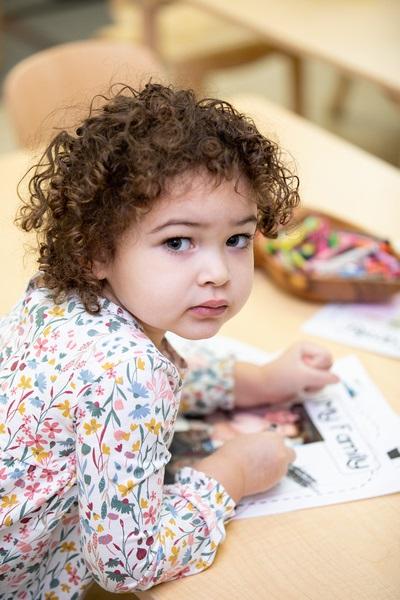
As young children interact with their literate world, they begin to explore a variety of writing tools, including paper, crayons, markers, pens, and digital writing tools such as phones and touchscreen tablets (Rowe, 2018). Their handling of writing tools becomes more proficient as their fine motor skills develop. Initially, young children have limited motor strength and control and, therefore, tend to grasp writing tools with their whole hand to make marks (see Table 9.3). As their motor skills develop, they may use their whole arm in an effort to control and direct their markings, scribbles, and drawings. Eventually, they use their fingertips to grasp the writing tool but their grip may be too high or too low. Likewise, it might be too loose or too tight. As they show increased fine motor strength and control, they are able to use three fingers to grip their writing tools to produce letters, words with invented spelling, and memorized words.
Table 9.3 Continuum of Emergent Reading Development: Handling Writing Tools
Handling Writing Tools
|
Developmental Progression |
CLLD3.3 Handling Writing Tools |
|
Early Infancy 0-8 months |
|
|
Later Infancy 6-14 months |
|
|
Early Toddler 12-24 Months |
|
|
Later Toddler 22-36 Months |
|
|
Early Preschool 34-48 Months |
|
|
Later Preschool 44-60 Months |
|
Table 9.3 is from Virginia’s Early Learning & Development Standards (ELDS): Birth-Five Learning Guidelines. It is used with permission of the creators and is not an open education resource covered by a Creative Commons License.
Similarly, many children are able to point and use their forefingers to make marks, draw, and scribble when using a touchscreen tablet (Crescenzi et al., 2014). As their fine motor skills develop, children use their fingers or a stylus on a touchscreen tablet to write letters, words with invented spelling, and words that are memorized (Rowe & Miller, 2015). Young children also learn to produce typewritten text, including their names, repeated letters, and words with invented spelling (Rowe & Miller, 2015). Digital tools also allow children to draw, use photographs and imagery, and record oral stories as they write (Eutsler et al., 2020).
As children experiment with and use a variety of writing tools and engage in daily opportunities to write and interact with peers and adults, they gain valuable insights into writing as a way to communicate ideas, stories, information, and opinions. At the same time, they develop important writing skills as they progress from making marks to using invented spelling and memorized or copied words to writing words, phrases, and sentences. As can be seen by the children in Mr. Jenbere’s and Ms. Daryl’s classroom, development along the continuum is individual. Accordingly, educators play an essential role in shaping an environment that promotes young children’s writing.
9.3d Factors That Influence Writing Development
Although developmental trajectories like those presented in the three tables representing the continuum of emergent writing development (Tables 9.1, 9.2, and 9.3) help educators understand how children develop their writing knowledge and skills, there are a number of factors that influence a child’s specific developmental pathway that must also be considered. As noted in previous chapters, children’s literacy development is shaped by (a) their home, community, and school environments; (b) the experiences children have with oral and written language within these contexts, including the languages they hear and speak; and (c) individual differences influenced by their unique abilities, developmental delays, and disabilities. The multiple influences on children’s development, including their literacy development, are important to keep in mind when examining individual children’s writing development and planning for appropriate assessment and instruction.
Similar to previous discussions about children’s language and emergent reading development, children’s prior knowledge, experiences, and interests contribute to variances in children’s writing development (Burns & Kidd, 2016). Children learn a lot about how print works as they interact with their world. Therefore, children’s experiences at home, in the community, and at school influence their writing knowledge and skills. Children interacting with a language- and print-rich environment will have different experiences with print than children who have limited access to print in their everyday lives. For example, children immersed in an environment with rich traditions of oral storytelling and/or daily storybook reading may have well-developed vocabularies in one or more languages and valuable understandings of story structures that they can apply to their own writing. Likewise, children who observe and take part in written communications at home, in their community, and at school develop insights into the functions of writing that help them understand that there are different purposes and types of writing as well as different audiences for their writing. In addition, children who are provided opportunities to explore writing tools and are encouraged to integrate writing into their play may develop an interest in writing and may be motivated to use writing throughout their day.
Children’s writing development is also influenced by the language or languages used in their home, community, and school. Children who are monolingual and those who are acquiring two or more languages may progress in different ways (Soltero-González & Butvilofsky, 2020). Young children who are acquiring two or more languages develop understandings about how print works as they encounter print in more than one language. For example, children who are simultaneous bilinguals are acquiring two languages at the same time and are learning about print in both languages. As their understandings of print emerge, they use what they know about print in one language to inform their understanding of print in the other language. This means that, when they begin to write, their understandings of print across both languages inform their writing in both languages (Soltero-González & Butvilofsky, 2020). Because patterns of development may differ by language or languages spoken, it is important to recognize there may be differences in writing trajectories among children who are monolingual, bilingual, and multilingual. Differences among languages and children who speak one, two, or more languages are especially important for educators to recognize when children begin to use their vocabularies and knowledge of letters and sounds to write.
Educators must also be aware of the effect that children’s abilities, developmental delays, and disabilities may have on children’s emergent writing development. Differences in how young children interact with and explore the world can affect the experiences they have to develop writing knowledge and skills. For example, young children with developmental delays and disabilities often have numerous doctors’ visits, therapy appointments, and other routines that take the family’s time and energy. The challenges and stress families may face as they navigate their child’s care and appointments may affect the opportunities children have to engage in literacy experiences (Hanser, 2010). Similarly, the nature of the developmental delay or disability may have an effect on how the child is able to engage in literacy-rich opportunities. For example, children who are sensitive to touch may not want to experiment with writing tools or children with short attention spans may not sit long during storybook reading (Hanser, 2010). In addition, children who use a wheelchair might be limited by what is in their line of sight and might not see environmental print that others might see (Hanser, 2010). Likewise, children with visual impairments can also be affected by how easy or challenging it is for them to access print in the environment (Guerette, 2014).
The type of developmental delay or disability may also have an impact on children’s emergent writing development. Children with specific language impairments, developmental delays, learning disabilities, or high-functioning autism might develop writing skills at a different pace (Burns et al., 2010). Children who are deaf and hard-of-hearing often begin school with less fully developed emergent writing skills than children who are hearing (Werfel, 2017). In addition, children with specific writing disorders might have challenges performing the motor activities required to hold a writing tool and write (Burns et al., 2010).
Because young children come to school with varied backgrounds and experiences, it is important for educators to recognize the writing knowledge and skills children bring with them to school. They must understand that children’s experiences with oral and written print differ from child to child. Many children come to school with rich experiences that foster their emergent writing knowledge and skills. Other children may come to school having had limited opportunities to hear stories, observe writing, and explore writing in their daily lives. In addition, children might have developmental delays and disabilities that influence their access to oral and print language or affect the pace at which they develop and learn. Recognizing the differing experiences and abilities children bring to the classroom allows educators to build on existing knowledge and skills to promote positive writing outcomes.
 9.4 Nurturing Emergent Writers
9.4 Nurturing Emergent Writers
Educators play an important role in nurturing emergent writers, especially when they work closely with family members to engage children in meaningful and relevant writing experiences. By getting to know children’s cultural and linguistic backgrounds and tapping into their prior knowledge and experiences, educators can implement culturally responsive assessment and instructional practices that promote children’s writing development. Therefore, educators support young children’s writing development by engaging families, assessing and monitoring young children’s writing, and providing developmentally and culturally appropriate writing instruction.
9.4a Engaging Families Through Writing
Working with and learning from children’s families helps educators understand and capitalize on the diversity children bring to the classroom. When educators have deep understandings of their children’s cultures, languages, and abilities and disabilities, they are able to design inclusive environments and engage children in culturally responsive writing assessment and instruction (Kidd & Burns, in press). By valuing each family’s unique experience and each child’s interests and abilities, educators create equitable opportunities for learning. Educational equity occurs when differences as well as similarities among children and their families are celebrated and children’s lives are reflected in positive and authentic ways in their learning experiences (NAEYC, 2019). Authentic writing opportunities that encourage connections between home and school and promote respect for children’s unique experiences foster a positive learning environment in which children’s development is optimized. When educators integrate authentic writing into the classroom and encourage children to write about their families and their everyday lives, they gain deeper understandings of children’s cultural and linguistic experiences.
Collaborating with families also ensures that the learning experiences in the classroom build upon and connect to children’s prior knowledge, experiences, and interests (Burns & Kidd, 2016). When educators tap into home writing practices, children are able to connect new learning to what they already know. For example, when educators know the types of writing that occur at home (e.g., grocery lists, notes to other family members, emails, text messages), they can incorporate opportunities to engage children in similar types of writing during instructional lessons and play experiences. Likewise, when children and families share stories about their family members, traditions, and their daily activities, the richness of their family and cultural experiences emerges. Their stories provide educators with insights that ensure children’s families, cultures, and languages are valued and recognized in the classroom.
In addition, by engaging families in writing activities that bridge home and school, educators provide opportunities for children to write about topics that are familiar to them. Young children are proud of their family and culture and love to share their experiences through their writing. Educators build on children’s natural interest in their family by creating opportunities to write about their families both at school and at home. In the classroom, educators often prominently display family photos taken during home visits or sent in by families. These photos encourage children to talk and write about their family. When the writings are taken home, they are shared with family members. Likewise, children and families may engage in writing projects at home and then bring their writing into school to share with their classmates. These home-school connections strengthen authentic bonds among children, families, and educators, which contribute to an inclusive learning environment and culturally responsive assessment and instruction practices.
9.4b Assessing Emergent Writers
Young children’s writing is a window into their thinking and understanding of the world. When educators take time to observe children as they write, talk with them about their writing, and examine the writings they produce, they gain valuable insights into children’s prior knowledge, experiences, and interests as well as their emergent writing knowledge and skills (Kidd et al., 2014). Educators use assessment data from formal and informal assessments to inform instructional decisions, evaluate their curriculum and instructional practices, and access services and resources for children (Kidd et al., 2019; National Research Council, 2008). For example, educators may use formal assessments that include writing components, such as the Transdisciplinary-Based Play Assessment (2nd ed.) (Linder, 2008), to develop learning goals, make instructional recommendations, monitor children’s progress over time, and determine eligibility for instructional services. They may also use assessments specifically developed to evaluate emergent writing that can document growth over time. For example, the Write Start! Writing Assessment can be used to document children’s writing forms, directionality, intentionality, and the content of the message (Rowe & Wilson, 2015).
As discussed in Chapter 6, assessing and monitoring young children’s literacy development is important to foster positive learning outcomes for young children. Although formal assessments can be helpful, most assessment practices in the early years are ongoing, informal assessments used to monitor progress and make decisions about curriculum and instruction. The information educators gather as they observe and intentionally interact with children as they write provides an assessment of what children can do. It also sheds light on the instructional supports and scaffolds needed to continue developing their emergent writing knowledge and skills. Assessing young children’s emergent writing is especially important for making instructional decisions that build on children’s interests, knowledge, and skills. Therefore, effective assessment must be as open ended as possible to allow children to express their ideas and demonstrate their understanding. Authentic creative writing experiences guided by children’s interests spark the unique abilities in all individuals. It is through open-ended and authentic assessments that the effective educator guides development.
Pause and Consider: Assessing Writing
In the opening vignette, after Richelle shared her thank you note with Mr. Jenbere, he paused to jot down anecdotal notes based on what he observed. He noted that Richelle views herself as a writer and seems to understand that writing has a purpose and an audience. She understands that a thank you note is written to show appreciation for something someone did. He also noted that although she mostly used letter-like forms, she was beginning to incorporate some letters into her writing. However, the letters did not correspond to the sounds in the words she read.
Later in the day, Mr. Jenbere and Ms. Daryl met to go over their notes. They both noticed that many of the children enjoyed writing thank you notes and understood their purpose. They decided to add folded cardstock and envelopes to their writing center, so children could make thank you notes or other cards on their own. They planned to introduce the new materials to the children the next day and invite those who wish to make cards to visit the writing center in the next few days. They also talked about what they noticed about individual children’s writing. For example, they discussed how to capitalize on Richelle’s new interest in writing alphabet letters in addition to letter-like forms. They decided to provide intentional opportunities for Richelle to use letters in her writing during centers. They checked to make sure there were writing pads and writing tools in each center, so they could integrate the activity into the context of Richelle’s play.
● How did Mr. Jenbere and Ms. Daryl assess their children’s writing?
● How did they use what is known about children’s writing progressions in their assessments?
● How did they use assessment data to plan instruction?
●Given the information provided, what types of instructional experiences might you consider providing for Richelle and her classmates?
9.4c Instructional Practices for Emergent Writers
The early years are an important time for educators and families to provide young children with experiences that develop not only letter-sound correspondence and handwriting skills, but also their understanding that print is read and writing is a way to communicate their ideas (Gerde et al., 2012). As discussed in previous chapters, there are many ways adults can support children’s literacy development, and specifically, their writing development. Through intentional and explicit opportunities to develop children’s writing knowledge and skills throughout the school day and at home, families and educators support children as they become proficient writers. These opportunities are provided when educators (a) create an environment that supports writing; (b) build on children’s prior knowledge, experiences, and interests; (c) integrate writing into play; (d) infuse writing across the curriculum; and (e) provide diverse instructional writing experiences (see Table 9.4).
Table 9.4 “Instructional Practices That Support Writing”

- Create uncluttered places with plenty of room for children to write and move around, keeping in mind that children are learning to regulate their bodies and are developing motor skills.
- Have tables and chairs that are the appropriate size and include space for children in wheelchairs and other positioning equipment.
- Provide a variety of writing materials and tools, including paper, dry erase boards, chalkboards, markers, crayons, pencils, chalk, tempera paint, water colors, finger paints, touchscreen tablets, styluses, and computers.
- Place writing materials and tools in places that are easy to reach and easy to put away, such as carts, shelves, tables, bins, and cubbies at the children’s level.
- Display meaningful print with pictures or braille around the room, including name strips, labels, posters, word cards, sentence strips, morning messages, and daily schedules.
- Position print and braille so it is visible and easy to reach.
- Include print and braille materials and writing tools in centers (e.g., children’s literature and magazines in the library, menus and writing pads in the restaurant, envelopes and writing paper in the post office, paper and crayons in construction areas)
- Display children’s drawings and writings.
- Engage families in children’s writing experiences.
- Encourage children to use their home languages and write about their home culture and family experiences.
- Ask children to draw and write about what they already know about topics of interest.
- Provide experiences that children can include in their writing, such as nature walks, field trips, hands-on experiments, class visitors, and experiences with community helpers (e.g., talking with firefighters and seeing a firetruck).
- Provide choice of writing tools and topics.
- Include accessible spaces for writing and writing materials and tools in each center.
- Model and explain how writing materials and tools may be used in the center.
- Remind children periodically to use writing materials and tools in the centers.
- Introduce new writing materials and tools into centers regularly.
- Include examples of different types of writing in the writing center, such as models of birthday cards or “I love you” notes to family members.
- Post theme-related and frequently used words in the writing center and around the room.
- Encourage children to copy words posted around the room and words written on cards or sentence strips in the writing center into their writing.
- Encourage children to write play plans that not only indicate where they plan to play (e.g., the kitchen center) but also how they plan to play (e.g., how they plan to share toys and props with classmates or what toys, props, and materials they plan to use).
- Provide intentional, child-specific scaffolding and reinforcement of writing knowledge and skills when interacting with children in centers.
- Follow the child’s lead when interacting with the child to provide scaffolding and instruction.
- Provide opportunities for children to write about what they are learning across the curriculum, including in mathematics, reading, science, and social studies.
- Incorporate writing activities that activate children’s prior knowledge (e.g., asking them to write about a topic, such as spring or fall, before instruction).
- Encourage children to draw and write about curricular content to foster their learning (e.g., documenting the growth of a plant, writing about sharing, comparing concepts such as hot and cold).
- Use children’s drawings and writing to assess their content knowledge (e.g., examining children’s drawings to assess their understanding of shadows or their writing to assess what they know about recycling).
- Provide opportunities for children to share and talk about their drawings and writing with adults and peers.
- Schedule time for writing instruction and provide opportunities throughout the day to write independently and with support.
- Encourage children to use a variety of writing materials and tools when writing, including digital tools such as touchscreen tablets and computers.
- Provide authentic writing experiences that develop children’s understanding of writing as a means to communicate with an audience (e.g., a story to share with classmates, a card to share with a family member, a note to persuade a parent to not make cooked carrots for dinner, an invitation for a community helper to visit their classroom).
- Include opportunities for children to identify and write their name by signing in for attendance, signing off when completing a task like toothbrushing, or signing up for a responsibility on the jobs chart.
- Model writing by engaging in shared writing experiences.
- Scaffold children’s writing through intentional interactions that develop their writing knowledge and abilities.
- Accept and encourage all forms of writing (e.g., scribbles, letter-like forms, letters, invented spelling).
- Encourage children to use letter-sound correspondence to write words with invented spelling.
- Ask children to read their writing or dictate their story and write down what they read.
- Promote children’s interactions with peers as they write.
- Provide opportunities for children to share their writing with others.
When educators create environments and provide instruction that foster young children’s emergent writing, children develop valuable knowledge and skills that prepare them for future success in school as well as in their daily lives. Assessment and instructional practices, like the ones listed in Table 9.4, are examples of the types of experiences educators provide to support young children’s writing development. As educators make decisions about curriculum, assessment, and instruction, it is important that they consider each child’s unique culture, languages, interests, and abilities. By being mindful of the diversity children bring to the classroom, educators provide an inclusive environment where each child feels valued and capable of learning.
Key Take-Aways
Additional Resources
Promoting Preschoolers’ Emergent Writing: https://www.naeyc.org/resources/pubs/yc/nov2017/emergent-writing
Virginia’s Early Learning & Development Standards (ELDS): Birth-Five Learning Guidelines. https://www.doe.virginia.gov/early-childhood/curriculum/va-elds-birth-5.pdf
References
Bialystok, E. (1992). Symbolic representation of letters and numbers. Cognitive Development, 7, 301–316.
Bruyere, J., & Pendergrass, E. (2020). Are your students writing or authoring? Young author’s milieux. Early Childhood Education Journal, 48, 561–571. https://doi.org/10.1007/s10643-020-01027-7
Burns, M. S., & Kidd, J. K. (2016). Play and early writing. In D. Couchenour & J. K. Chrisman (Eds.), Encyclopedia of contemporary early childhood education (pp. 1026–1028). SAGE. https://www.doi.org/10.4135/9781483340333.n305
Burns, M. S., Kidd, J. K., & Genarro, T. (2010). Writing: Underutilized for young children with disabilities? In T. Scruggs & M. Mastropieri (Eds.), Advances in learning and behavioral disabilities: Literacy and learning (Vol. 23, pp. 175–204). Emerald Group.
Byington, T. A., & Kim, Y. (2017). Promoting preschoolers’ emergent writing. YC Young Children, 72(5), 74–82. https://www.naeyc.org/resources/pubs/yc/nov2017/emergent-writing
Crescenzi, L., Jewitt, C., & Price. S. (2014). The role of touch in preschool children’s play and learning using iPad versus paper interaction. Australian Journal of Language and Literacy, 37(2), 86–95.
Eutsler, L., Miller, C., Stamm, B., & Kogut, A. (2020). The influence of mobile technologies on preschool and elementary children’s literacy achievement: A systematic review spanning 2007–2019. Educational Technology Research and Development, 68, 1739–1768. https://doi.org/10.1007/s11423-020-09786-1
Gerde, H. K., Bingham, G. E., & Wasik, B. A. (2012). Writing in early childhood classrooms: Guidance for best practices. Early Childhood Education Journal, 40, 351–359. https://doi.or/10.1007/s10643-012-0531-z
Goodman, K., & Goodman, Y. (1983). Reading and writing relationships: Pragmatic functions. Language Arts, 60(5), 590–599.
Guerette, A. R. (2014). Compensatory access. In C. B. Allman & S. Lewis (Eds.), ECC essentials: Teaching the expanded core curriculum to students with visual impairments (pp. 61–108). AFB Press.
Hanser, G. (2010). Emergent literacy for children with disabilities. American Occupational Therapy Association. https://www.aota.org/-/media/Corporate/Files/Practice/Children/emergent-literacy-for-children-with-disabilities.pdf
Kidd, J. K., & Burns, M. S. (in press). Promoting writing with reading and learning. In S. B. Wepner & D. Quatroche (Eds.), The administration and supervision of reading programs (6th ed., pp. 382–406). Teachers College Press.
Kidd, J. K., Burns, M. S., La Croix, L., & Cossa, N. L. (2014). Prekindergarten and kindergarten teachers in high poverty schools speak about young children’s authoring (and we need to listen). Literacy and Social Responsibility, 7(1), 50–71.
Kidd, J. K., Burns, M. S., & Nasser, I. (2019). Promoting intentional teaching: The LEARN professional development model for early childhood educators. Paul H. Brookes Publishing.
Kissel, B. ( 2018). Listen, ask, and study: Reimagining how we interpret prekindergarten writing. Language Arts, 95(4), 242–247.
Kissel, B., Hansen, J., Tower, H., & Lawrence, J. (2011). The influential interactions of prekindergarten writers. Journal of Early Childhood Literacy, 11(4), 425–452. https://doi.org/10.1177/1468798411416580
Kissel, B. T., & Miller, E. T. (2015). Reclaiming power in the writers’ workshop: Defending curricula, countering narratives, and changing identities in prekindergarten classrooms. The Reading Teacher, 69(1), 77–86. https://doi.org/10.1002/trtr.1379
Linder, T. (2008). Transdisciplinary play-based assessment (2nd ed.). Paul H. Brookes Publishing.
National Early Literacy Panel (NELP). (2008). Developing early literacy: Report of the National Early Literacy Panel. https://lincs.ed.gov/publications/pdf/NELPReport09.pdf
Pelatti, C. Y., Piasta, S. B., Justice, L. M., & O’Connell, A. (2014). Language- and literacy-learning opportunities in early childhood classrooms: Children’s typical experiences and within class variability. Early Childhood Research Quarterly, 29, 445–456. https://doi.org/10.1016/j.ecresq.2014.05.004
Puranik, C. S., & C. J. Lonigan. (2014). Emergent writing in preschoolers: Preliminary evidence for a theoretical framework. Reading Research Quarterly, 49(4), 453–67. https://doi.org/10.1002/rrq.79
Rowe, D. W., & Wilson, S. (2015). The development of a descriptive measure of early childhood writing: Results from the Write Start! Writing Assessment. Journal of Literacy Research, 47(2), 245–292. https://doi.org/10.1177/1086296X15619723
Soltero-Gonzalez, L., & Butvilofsky, S. (2020). Emergent sound-letter correspondence in the early bilterate writing development of simultaneous bilingual children. Journal of Research in Childhood Education, 34(3), 346–366. https://doi.org/10.1080/02568543.2019.1703123
Sulzby, E., & Teale, W. H. (1985). Writing development in early childhood. Educational Horizons, 64(1), 8–12. https://www.jstor.org/stable/42925853
Virginia Board of Education. (2021). Virginia’s early learning & development standards (ELDS): Birth-five learning guidelines. https://www.doe.virginia.gov/early-childhood/curriculum/va-elds-birth-5.pdf
Werfel, K. L. (2017). Emergent literacy skills in preschool children with hearing loss who use spoken language: Initial findings from the early language and literacy acquisition (ELLA) study. Language, Speech, and Hearing Services in Schools, 48, 249–259. https://doi.org/10.1044/2017_LSHSS-17-0023
Image Credits
Figure 9.1: Kalyca Schultz and Leslie LaCroix. “Framework for Developing Emergent Literacy.” CC BY 2.0
Figure 9.2: Julie Kidd. “Scribbles, Letter-Like Symbols, and Letter Formations.” CC BY 2.0.
Figure 9.3: Julie Kidd. “Letter-Sound Correspondence.” CC BY 2.0.
Additional Images
Image, Section 9.2: Lucy La Croix. [Nest] CC BY 2.0.
Image, Section 9.3: Lucy La Croix. [Bird] CC BY 2.0.
Image, Section 9.3c: Longwood University. [Child Using Writing Tools] CC BY-NC-SA 2.0.
Image, Section 9.4: Lucy La Croix. [Branch] CC BY 2.0.

